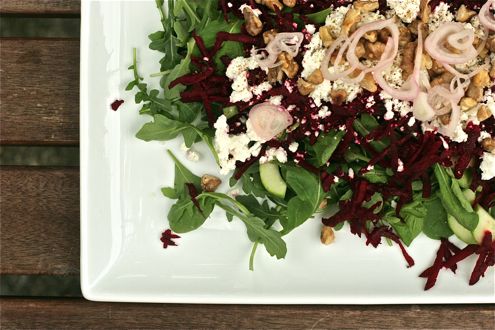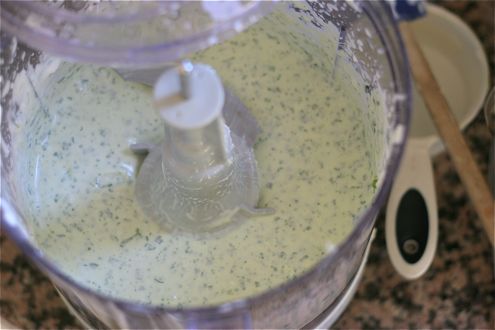I have been having an incredibly good time in my kitchen this week, inspired by the first sunny and (slightly) warm weather we have had here in Seattle since…September? Seattle is blooming and everything that has been brown and wet for so long is now green. (And wet. Sigh.) Still, the green is a huge improvement. Now I want to make green food.
First there was the riff on a dish of black rice, clams, aioli and cilantro that I had at Sitka and Spruce – except I made it with sear-roasted halibut. The cilantro made it a little bit green. I loved seeing it bright and fresh in the photo. The flavor with the lemon was pure sunshine. Here’s what it looked like:

My friend Christine thoughtfully brought over an Alsatian Riesling to drink with it and it was perfect, more so because I got to share it with a really good friend. As soon as I have a chance to make the halibut again, I’ll take pictures and post the method. I want to show you how to make aioli.
Still, I wanted the food to be greener. So I made up this very very green salad – toying with a dressing from Deborah Madison, spring asparagus, arugula, goat cheese and toasted pine nuts. Here it is:

So, there’s the bitter asparagus and the even bitterer arugula. But the asparagus’ pungency is tempered by it’s bout with the broiler. The flavor becomes rounded, richer, a little nutty. The goat cheese was something leftover from the dinner party, the sort with colored peppercorns. Martin toasted the pinenuts – for warmth and crunch. Then there’s the dressing, borrowed from Deborah Madison’s Vegetarian Cooking for Everyone. I skipped a couple of things – the big one being the capers. Here’s what Nora Ephron says about capers:
Any dish that tastes good with capers in it tastes even better with capers not in it.
I agree 100% and I feel validated in my opinion because Nora Ephron said it first.
Anyway, the dressing. I made it for this cabbage and arugula slaw that I was sure would be wonderful (it wasn’t) but the dressing had potential. (without the capers!) Garlic, salt, fennel seed and black peppercorns are mashed together with a mortar and pestle and then left to macerate with olive oil, shallots and lemon rind. It’s complex. Fire from the garlic and peppercorns, high spring notes of fennel and lemon and the edge-y richness of sliced shallots and champagne vinegar. Without the capers, it’s pretty fantastic. This is an extremely green, salad tour de force. I think after this cold and gloomy winter what I needed was a giant hit of chlorophyll.
With the salad, we made the grilled shrimp with bread crumbs from Marcella Hazan’s Essentials of Italian Cooking that I wrote about last summer and the white bean and basil puree that I wrote about when I first started writing Notes on Dinner. And here is how to make the green salad:

Asparagus Salad with Arugula, Goat Cheese and Pine Nuts – serves 4
- 1 bunch of asparagus, rinsed, ends snapped off
- 2 tbsp olive oil
- sea salt and pepper
- 4 generous handfuls of arugula, washed and dried
- 1 ounce goat cheese – with peppercorns, if you like that sort of thing, crumbled
- 2 tbsp pine nuts, toasted in a small dry skillet over medium heat until glossy and golden
The Dressing (for this you will need a mortar and pestle)
- 1 clove garlic
- 1/4 tsp sea salt
- 1/4 tsp fennel seeds
- 1/4 tsp peppercorns
- 1/2 tsp dry tarragon
- 1/4 cup parsley, minced and divided
- 1 shallot, thinly sliced
- 1 zest of a lemon – finely grated with a microplane
- 1/3 cup olive oil
Preheat the broiler – set it to high.

In the mortar and pestle, mash the garlic, sea salt, fennel seeds, peppercorns, tarragon and 2 tbsp of the minced parsley until you have a smooth paste.
Stir in the lemon zest, shallots, the rest of the parsley and olive oil and leave to macerate for 1/2 an hour.

While the salad dressing is resting, arrange the arugula on a large platter.
Then toss the asparagus with 2 tbsp olive, 1/2 tsp sea salt and several grindings of black pepper on a rimmed sheet pan. It should be in one layer. Broil 4 inches from the heat until bubbling; toasted but still crisp/tender. My asparagus was just under 1/2″ in diameter and this took about 2 minutes per side – a total of 4 minutes.

Remove the asparagus from the pan and arrange while still hot, over the arugula.
Strew the crumbled goat cheese and pine nuts over everything.
Add the champagne vinegar to the dressing and taste. Does it need more salt?
Ladle the dressing over the salad – depending on how much asparagus and arugula you have, you may not need all of it.
So I have this photo of the dinner and I’m not crazy about it. I don’t like to make excuses when I think something is lame; as my aunt says: you have to feign nonchalance in these situations. But this is sort of funny. My boys were so desperate to get their hands on this dinner (they both love Ms. Hazan’s juicy and crisp shrimp) that when I wanted to stop for less than sixty seconds to take the picture, they both started to cry! So I stopped messing about and served dinner. Everyone was happy. Here’s the photo:
 It could have been a lot prettier but seriously, it was totally delicious.
It could have been a lot prettier but seriously, it was totally delicious.







































